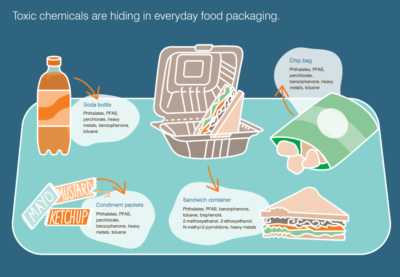If you’re like most people, you enjoy opening your dryer door and removing clothes, sheets and kitchen towels that have a fresh, clean scent. And on days you forgot to take out the garbage, you’d probably prefer to never come home again to find the smell of your house resembling a cross between a spoiled potato and a wet dog.
If you’re like most people, you may also find yourself reaching for the store-bought, chemically concocted fabric softeners, room sprays and candles promising to cover up or mask unpleasant household smells, even if you’re not sure what they’re made of. Whether or not you’re bothered by the strong scents you encounter when you walk into the cleaning aisle at your local supermarket, those heady fragrances are loaded with toxins that are anything but good for you or anybody else.
In fact, more than 100 volatile organic compounds (VOCs — read: carcinogenic) waft their way through your home from the laundry products you use, including detergents, liquid fabric softeners and dryer sheets. If you’re looking for a product that can cut through odors, but you’d rather use something that’s all-natural and free of artificial fragrances and dyes, here’s some good news — you can make your own, and all you need are four ingredients.
Recipe For An All-Natural, Homemade Odor Eliminator
This recipe for a completely natural fabric and room freshener spray rivals anything you can buy at your local supermarket or dollar store, but without the toxic ingredients. In fact, other than water, the other three ingredients contain powerful and unique healing properties. Here’s all you need:
- 1 cup (8 ounces) of water
- 6 droppers of colloidal silver (about 1/2 tablespoon)
- 40 drops of lavender oil (about 1/2 teaspoon)
- 40 drops of eucalyptus oil (about 1/2 teaspoon)
Mix the ingredients in a glass measuring cup, then pour into a spray bottle and shake gently before each use. It’s that easy. (Note — it’s always a good idea to test a small corner of any fabric before applying essential oils.) The ingredients in this spray are derived from plants and minerals, quite unlike those chemical-laced offerings designed to make your laundry, kitchen, furniture, bathrooms and other areas of your household smell nice.
The formula has been carefully considered, as for one thing, lavender essential oil is recommended for clothing as opposed to other oils like lemon that may stain your clothes. Eucalyptus and lavender both contain a number of purifying compounds, and colloidal silver has powerful antibacterial, antifungal and antiviral properties.
The Attributes Of Lavender Oil
Lavender (Lavandula angustifolia) oil has been used for millennia, as far back as the ancient Greeks and Romans. It was often used in bathwater for both purification and fragrance, hence, the word “lavender” which means “to wash” in Latin. Lavender is a natural disinfectant and deodorant that’s been used in the most primitive settings, even for mummification.
Today, it’s a common ingredient in laundry soap, shower gels, candles and drawer sachets. Lavender oil is also an effective and soothing emollient to massage into your skin. Add it to an Epsom salt foot bath for sore, tired feet, and be aware that vaporized lavender oil is effective as a muscle relaxer. The light fragrance is also noted for helping relieve insomnia.
One reason lavender is effective for all these purposes and in healing is because of its VOCs, explaining why it’s so soothing added to a hot compress to ease the pain of sprained muscles or tendons. With over 150 different components, pure lavender oil is chemically complex, with antifungal, antidepressant, antibacterial, antimicrobial, antiseptic and numerous other “anti” properties that do more than smell nice.
Eucalyptus Oil — Uses And Description
If you’re unfamiliar with the smell of eucalyptus, suffice it to say that it’s strong, so it doesn’t take a lot to produce a unique, sweet, woody smell used in early surgical forays as an antiseptic — even to clean urinary catheters in 19th century England.
The oil of Eucalyptus globulus — and there are around 500 types — has been shown in clinical studies to treat pain and inflammation associated with bronchitis, colds, rhinosinusitis and asthma. As an antiseptic, the oil is effective used on wounds, burns and ulcers.
Besides stimulating your immune system, the oil also has the ability to exert pain relief and alleviate anxiety. Somewhat similar in terms of fragrance to mint, eucalyptus is often used in mouthwashes, cough drops, ointments and cleaning products because the clean scent seems to penetrate your nasal passages, but in a good way.
Beauty products containing eucalyptus also impart moisturizing benefits. The chemical makeup of eucalyptus includes limonene and alpha-terpineol. Cineol is the most prominent constituent, taking up 84.39% of total oil volume in the plant.
Colloidal Silver Effective Against Antibiotic-Resistant Pathogens
Silver used against pathogens is, surprisingly, not a new thing. In fact, Hippocrates explained its abilities against pathogenic bacteria in around 400 B.C. In modern times, clinical studies have identified colloidal silver as strong enough to eradicate even antibiotic-resistant super pathogens. Interestingly, research shows that silver has the capacity to multiply the effectiveness of antibiotics as much as a thousand times.
A study published in BioMed Research International reported that silver added to an antibiotic called vancomycin rendered it powerful enough to kill gram-positive bacteria such as staph and strep. It can also defeat gram-negative bacteria like those implicated in dangerous infections associated with hospitals, such as E. coli.
Another study revealed that a small amount of silver added to the same antibiotic obliterated a urinary tract infection caused by tetracycline-resistant E. coli. There’s also clinical evidence that silver is effective for faster wound-healing and may boost immunity by helping fight off infections. As an added boon, it has a long shelf life.
Over the last several decades, the use of silver as an antibacterial faded into the background as a seemingly old-fashioned remedy. But that was before super bugs came along. Today, silver’s effectiveness and versatility has proven itself once again as a dramatically effective mineral against illness and disease.
Toxic Ingredients In Cleaning, Laundry And Deodorizing Products
If you’re an avid label reader, you may be dismayed to find that many of the chemicals used to make air fresheners and other cleansing and laundry products may not even be listed. Toxin Detective observes:
That’s because most companies keep fragrance ingredients a secret since they can claim that they are ‘confidential business information’ and trade secrets. This scent ingredient secrecy occurs wherever synthetic fragrances are found (perfumes, cosmetics, personal care products and cleaning products to name a few), and it is especially egregious when it comes to air fresheners because fragrance makes up most of the product.
Some of these ingredients include phthalates, which are known hormone disruptors, and a nerve-deadening chemical that imparts the ability to stop smelling bad smells because it literally blocks your olfactory nerves. That’s how it so effectively “masks” other odors. In addition, the VOCs from your dryer and household venting system include acetaldehyde, acetone and ethanol.
The Environmental Protection Agency uses terms like “neurotoxic,” “hazardous,” “linked to cancer,” “developmental toxin” and causing potential nervous system damage to describe these chemicals.
Further, these chemicals are almost instantly absorbed into your system when you inhale them, which may explain the woozy feeling you may experience when you walk down the candle, perfume or cleaning aisles referred to earlier, as they can affect your respiratory, neurological, endocrine and immune systems.
One study notes that fragrance products can cross your blood-brain barrier, and many of the thousands of chemical agents in fragrances have psychoactive properties, just like psychoactive drugs.
Incredibly, that’s what the majority of American households spray in their bathrooms, living rooms, bedrooms, cars, offices and worst of all, nurseries. Here’s a sobering study — fragrance reactions in the workplace are now so common that detrimental effects are being compared to those of secondhand smoke.
The sad fact is, not only are companies not required to fully disclose all the ingredients they use, there’s really no way of knowing the percentages they’re using. You may already be aware that pet birds have been known to fly through the mist of a spritz of room freshener and drop dead on the spot.
Tips For Eliminating Persistent, Noxious Odors
Some odors are not just more annoying than others, but those are the ones that often seem to be the most difficult to get rid of. In getting rid of dirt, grime and other unpleasant stains and substances, the smell will often depart at the same time. When the time comes to eliminate hard-to-handle household smells, here are some methods using natural ingredients you may already have on hand:
- Pet smells — Assuming you’ve cleaned out your cat box, rather than using cat litter or carpet cleaners loaded with chemicals to eliminate odors, certain surfaces call for different cleaning methods.
- Natural cleaners like hydrogen peroxide, vinegar or baking soda can be used on fabrics and carpeting as well as wood and other hard surfaces. Resist the urge to rub or scrub; blotting with a wet paper towel actually does a better job, although it may need repeated applications.
- Bathroom smells — A toilet cleaner alternative consists of a combination of 1/2 cup of baking soda and about 10 drops of tea tree essential oil into the toilet bowl, followed by 1/4 cup of vinegar. Scrub with a toilet brush.
- Laundry smells — Using a gallon-sized jug, add 2 cups of baking soda and 2 cups of white vinegar. When the mixture stops foaming, add 4 cups of hot water and essential oils of your choice to desired strength. (You could try using 20 drops each of lavender and lemongrass oil.) Shake before each use and add about 1 cup for large loads in the rinse cycle.
You may not be able to avoid coming into contact with harmful substances created in a misguided attempt to improve the not-so-pleasant smells you encounter from day to day. However, you can keep from adding to them by putting together your own homemade products that will make you healthier, rather than causing harm.
Original article here



 By the time you open a container of yogurt, the food has taken a long journey to reach your spoon. You may have some idea of that journey: From cow to processing to packaging to store shelves. But at each step, there is a chance for a little something extra to sneak in, a stowaway of sorts that shouldn’t be there.
By the time you open a container of yogurt, the food has taken a long journey to reach your spoon. You may have some idea of that journey: From cow to processing to packaging to store shelves. But at each step, there is a chance for a little something extra to sneak in, a stowaway of sorts that shouldn’t be there.
 In the U.S., millions of shoppers pack clothing stores, excited to key into the newest trends while paying low prices. On the other side of the world, low-wage workers—many of them young girls— are crushed under the hammer of “fast fashion” (the mass production of cheap, poor quality, disposable clothing), laboring without safety protections or adequate rights. Fast fashion’s impacts on both the environment and human rights are evident, and slow fashion may just be the only solution to a greener future.
In the U.S., millions of shoppers pack clothing stores, excited to key into the newest trends while paying low prices. On the other side of the world, low-wage workers—many of them young girls— are crushed under the hammer of “fast fashion” (the mass production of cheap, poor quality, disposable clothing), laboring without safety protections or adequate rights. Fast fashion’s impacts on both the environment and human rights are evident, and slow fashion may just be the only solution to a greener future.